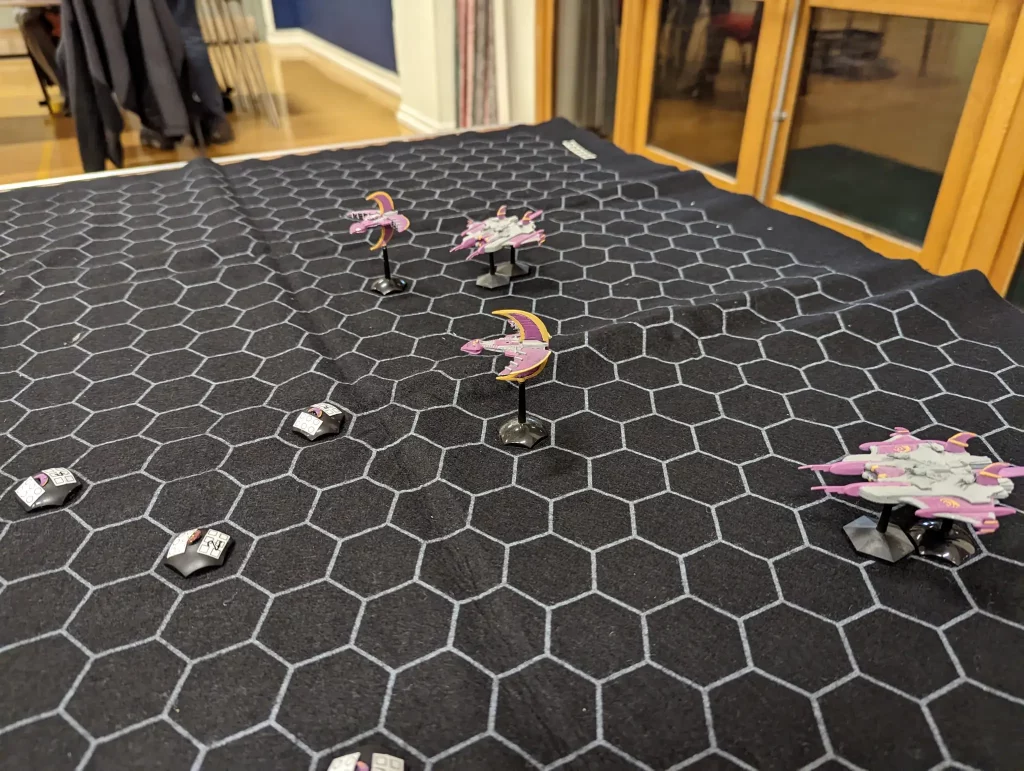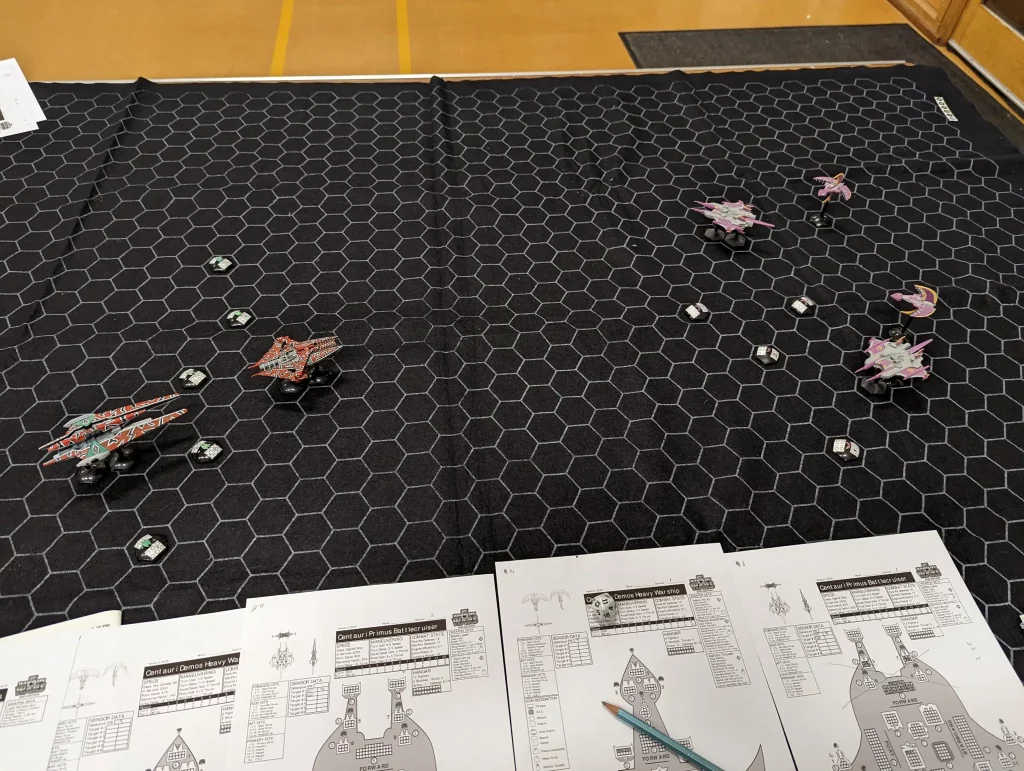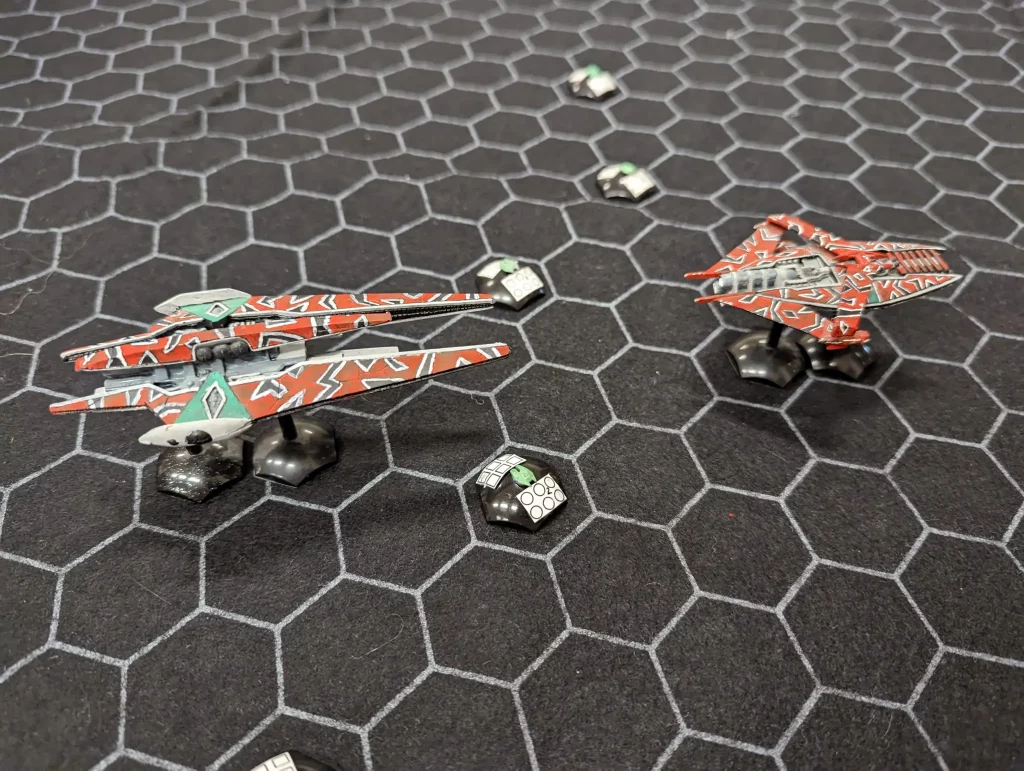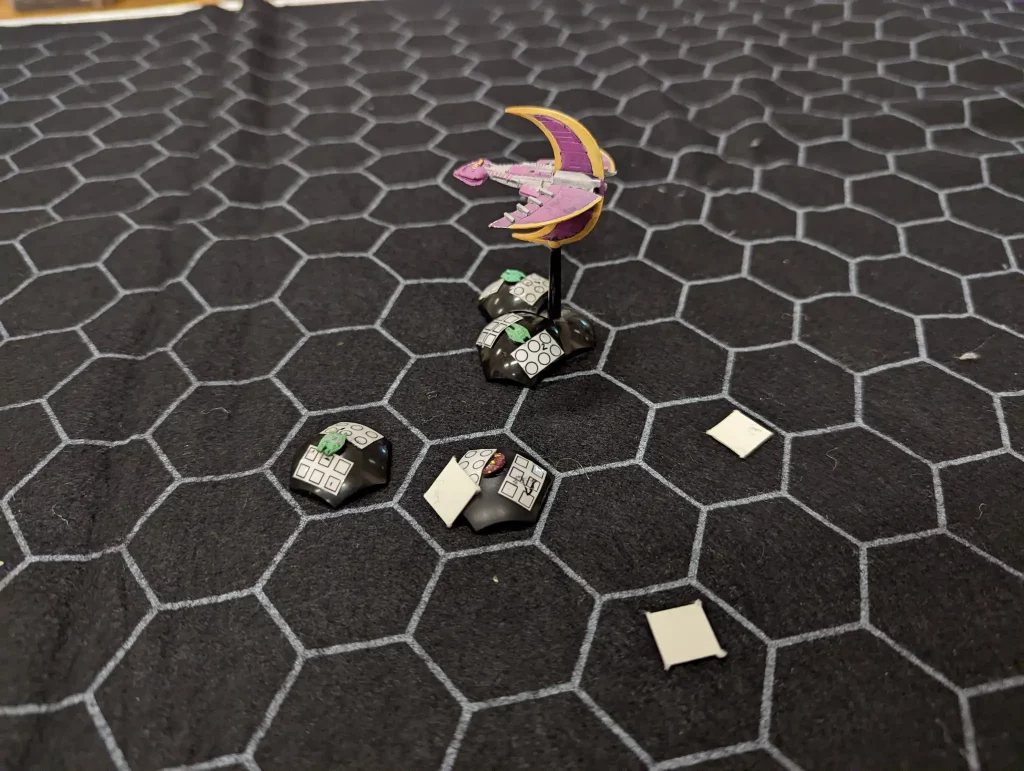Sink the Bin’Tak
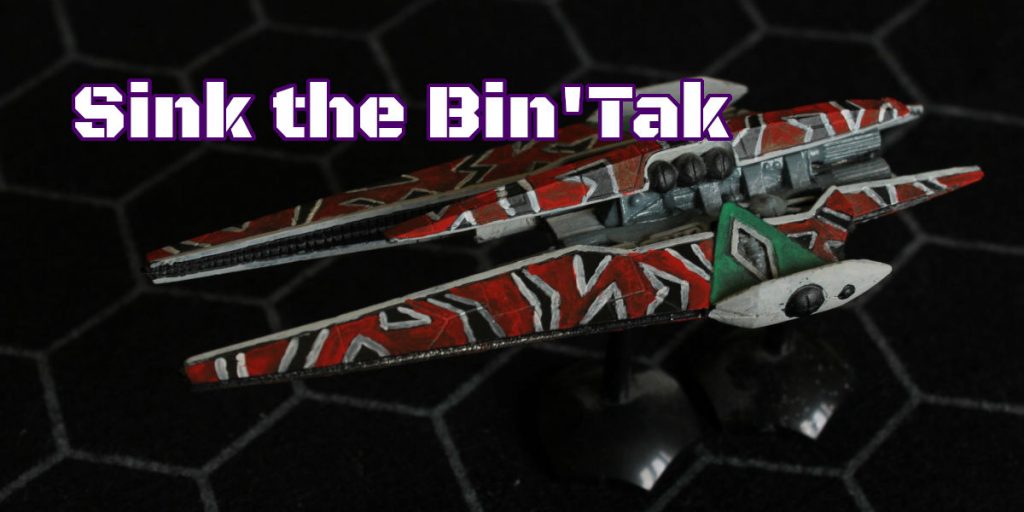
It is nearing the end of the Narn-Centauri War in 2259, and Centauri intelligence have discovered that one of the last Narn Bin’Tak class dreadnaughts is hiding out in a small, unremarkable star system whilst it repairs its jump drives. It is supposedly undefended, so it seems like a good opportunity to make a quick strike and finish it off.
And so began our evening game of Babylon 5 Wars. Like Full Thrust, it’s a space combat wargame played out on a two dimensional table top. Unlike Full Thrust, it’s a lot more complicated. We’d normally complete a six turn game of FT in an evening, with a bigger fleet. For B5W, we completed two turns. Admittedly it was our first game in some 15 odd years, but it’s a lot more in depth. It’s not necessarily a bad thing, but it is definitely a thing.

As it’s name suggests, B5 Wars is based on the nineties SciFi TV show of the same name. It is very faithful to the series, and has ships and rules for most of the races seen in the series. Produced by Agents of Gaming, they released a very nice set of miniatures to go with the game. Later, they released some smaller miniatures and a set of ‘Fleet Action’ rules for running bigger battles, but for this game we used the original miniatures along with the 2nd edition of the original ruleset.
In comparison to a game like Full Thrust, some of the extra complexities of the rules can be summed up as follows:
- Ships have hit locations. They have different structures (fore / aft / port / starboard / primary) and each structure has its own hit location table.
- Damage is applied to each specific location. If you take damage in a heavy beam laser, then your heavy beam laser takes damage. Each item or location has its own armour value and number of hull points. Destroy an item, and the damage goes through to the structure it’s attached to.
- Weapons can do damage in different ways, and some weapons give you a choice of how they’re used. A raking attacking is different to a piercing attack or flash damage.
- There is power management, and you can shut down some systems to give extra power to other systems.
- There is electronic warfare. Do you want to jam the enemy so they find it harder to hit you, or do you want to light up an enemy target to make them easier to hit?

We had two ~3,500pt fleets, with the Centauri having a slight edge. The Narn had a single Bin’Tak class dreadnaught, along with a G’Quon heavy cruiser. With these came five flights of heavy fighters. Their mission was to get the Bi’n’Tak from one edge of the table to the other. This should take 5-6 turns assuming continuous acceleration.
The Centauri had a slightly larger fleet with two Primus class battlecruisers and two Demos heavy warships. This gave them four flights of light fighters. Their mission was to destroy the Bin’Tak whilst trying not to sustain heavy losses themselves.
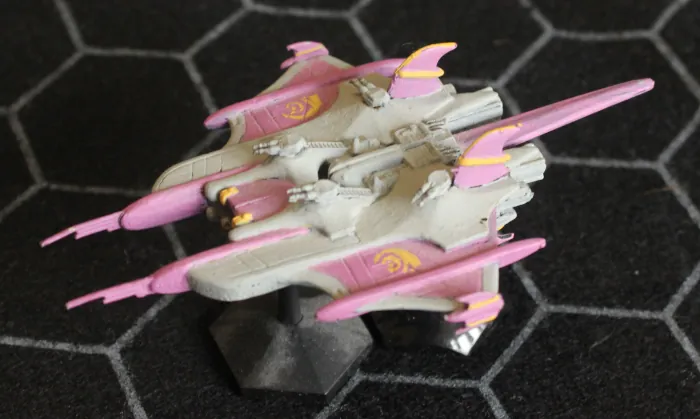
As the Centauri player, I was most concerned about the energy mines of the Narn, and also their fighters. They outnumbered me on fighters, and their fighters were also heavier.
On the other hand, I had twice as many ships so I was also concerned that the battle could be over very quickly. The Primus has a lot of big guns, and with two of them they might be able to make short work of a single ship, even if it was a Dreadnaught.

The plan for the two Demos Heavy Warships (the models are actually Vorchan Warships, but they look similar enough and with two Vorchan’s the Centauri would have been seriously under pointed) was to rapidly get behind the dreadnaught and attack from the rear, using their ballistic torpedoes. Classed as heavy combat vessels rather than capital ships, their speed and manoeuvrability were much better than the other ships. But they are also lighter and more fragile.
The game started with both fleets at either end of the board, with all fighters deployed, and us rolling for initiative. Initiative is done for each individual ship, using a d20 plus a bonus. Capital ships get a +0 bonus, heavy combat vessels +6. Each fighter group also rolls, with the Narn heavy fighters getting a +16 and Centuari light fighters getting +18. Basically, fighters are very likely to get higher initiatives, but it isn’t guaranteed.
After this, we determine Electronic Warfare for ships. This is one of the features I quite like about the game, and it matches some of the way ship to ship combat happened during the TV show. Every ship has a sensor rating (e.g. +10 for a Primus), which can be split between sensor locks on enemy ships, defensive EW, or close combat EW (for use against fighters).
Both my Demos went fully defensive, and the two Primus’ went fully aggressive against the Bin’Tak. They each had four battle lasers, which could fire once every three turns. The plan was to open up at long range with two each, then the next two on the second turn. They’d have to rely on smaller weapons on turn three, but by turn four should be lined up to start using their primary weapons again.
At a range of just over 40 hexes, they had a penalty of about -15 to hit (on a d20). Each ship’s chance to be hit depends on its profile, and a Bin’Tak is hit on a 16 or less from the front or rear, or 18 from the sides (I did say that the system was detailed). The +10 from the Primus EW brought this total up to 11, and then another +4 from the weapons themselves when firing at capital ships. So they actually had a reasonable chance to hit. Except the Bin’Tak was putting most of its points into being defensive, so this brought the target number to just under 10 (you need to roll low).
If you don’t put any EW points into ‘locking onto’ a target, then not only do you not get a bonus, but all range penalties are doubled. This pretty much means you have to declare who you might be firing at before movement, allowing the enemy to make changes to their movement decisions depending on who is being targetted.
Movement happens in reverse initiative order – the lowest initiative move first, allowing faster ships to react to that movement. Ballistic weapons, such as energy mines, are also fired at the start of movement, with energy mines targeting a hex rather than a ship. This is where our planning for the game broke down. I have a very nice felt hex ‘blanket’ for games like this, but it doesn’t have any numbers on the hexes. This made it trickier for the Narn’s to secretly record where their energy mines were being dropped.
We moved, then ships opened up with their first shooting. Energy mines came first, with a Demos taking light damage from a nearby mine which took out a retro thruster – but there were no direct hits.
The Bin’Tak’s first volley hit my Primus with a heavy battle laser, which was significantly heavier than I’d expected. Lasers can do either raking or penetrating attacks. For raking, damage is divided into blocks and each block is applied to a different hit location. Penetrating is split across the ship (fore, primary and after for hits to the front), which damage being applied to each section. This was a raking attack, but most hit my primary structure resulting in the front of the Primus falling off.
The two Primus battlecruisers replied, with light damage to the Bin’Tak. I also used raking attacks, which were split pretty randomly across locations on the hull.
It had taken us about two hours to get to this point, from initial arrival and setting up tables and getting out the miniatures to end of the first turn. There had been a lot of checking of the rules, measuring of hexes and plotting of movement.
Movement is tricky. It’s hex based, but also makes an attempt to use simplified Newtonian movement. I think the attempt to keep it simple actually complicates it. Ships move along hex facings, and can spend thrust to accelerate or decelerate. Turning 60° costs thrust points, and the faster you are going the more it costs. You can also pivot and roll if you want to slide past an enemy whilst shooting your forward guns.
A ship also has to wait before it gets to turn, so you can’t make a 120° turn without moving in-between. There is the concept of agile ships (think of the White Star) which can turn more rapidly, and fighters have much more flexible movement. Fighters still have a speed and acceleration/deceleration cost though.
By turn two the range had pretty much halved, and fighters were beginning to engage. Since I hadn’t been targetting the G’Quon, it had been able to go fully offensive with its EW, so I decided to try and hurt it with my fighters. The two Centauri battlecruisers manoeuvred to bring their second battery of battle lasers to bear on the Bin’Tak, and the Demos tried to avoid energy mines and get around the flanks.
Most of the Narn fighters decided to target one of the Demos, which I tried to protect with a single flight of fighters. Unfortunately, my fighter flight flew directly into an energy mine and was utterly destroyed. The mine also hurt one of the Narn fighter flights, but didn’t take them out.
The Narn fighters against the Demos did a lot of superficial damage, taking out some weapon systems and retro thrusters, as well as causing damage to the forward structure. A ion torpedo from the Bin’Tak also didn’t help things.
My fighters tried to swarm the G’Quon, but took heavy damage from Narn fighters. A hit from a Narn fighter was pretty much guaranteed to take out a Caentauri fighter. Any damage that they did was superficial.
The Centauri capital ships continued to do superficial damage to the Bin’Tak. Though a few hits on the ship’s damage was caused, and some energy mines were taken out, it was still in good condition. I think we got the rules wrong on ships versus fighters, but we didn’t have time to sit down and double check everything. Possibly the Demos should have been able to better defend itself.
By the end of turn two, things had gone badly for the Centauri. They had lost much of their fighter support, whilst the Narn’s were still in good condition. A Primus was missing it’s front section, whilst the Bin’Tak was still in good condition. In another three turns it would have escaped.
We had pretty much run out of time for the evening though, so we decided to call it. The Centauri would back off and not risk losing their lives over a minor engagement in a war they’d already pretty much won. If we’ve continued, I think things could still have gone either way, but it would have been at high cost to the Centauri.
Overall, the game demonstrated that we really need to spend more time understanding the rules. It also turned out that the 2nd edition supplement for the War of Retribution, which includes a lot of the Narn/Centauri specialist weapons, is merely an update pack for the 1st edition version. I didn’t have the 1st edition version with me so we didn’t have full information on some of the weapons.
Babylon 5 Wars is a complicated game (compared to something like Full Thrust). It’s definitely designed for smaller ship engagements, but the detail can be a lot of fun once you’re comfortable with it. It really helped that the Ships of the Fleet supplements included CDs that contained PDFs of all the ship data sheets, which for something released in 2000 was quite forward thinking. It makes it easy to pick up the game again after over 20 years of it being published.
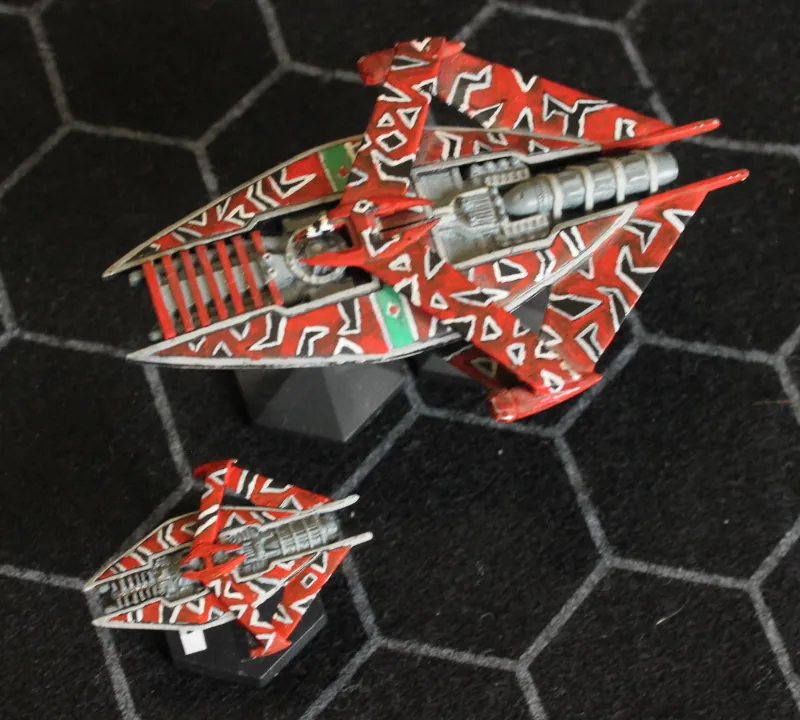
This is not the only wargame to cover Babylon 5. As mentioned already, there is a set of ‘Fleet Action’ rules from the same company which are simplified and designed for larger fleet battles.
The miniatures are smaller, but match the larger versions accurately. The small miniatures are also much more durable. After over twenty years of storage many of my larger models are broken due to the difficulty in storing them safely.
There was also the Earth Alliance Sourcebook which was a supplement for the Babylon 5 RPG which included a ship combat set of rules based on Full Thrust (they were designed by Jon Tuffley).
I also have A Call to Arms: Babylon 5 Space Combat, a game by Mongoose Publishing which has been sitting on my shelf for years but has hardly been looked at. I probably need to investigate it at some point.
Babylon 5 is probably my favourite science fiction series, at least partly because it’s highly gameable. It has a rich background for setting an RPG in, with the right level of SF hardness for my tastes. The Expanse is really good, but the choices of type of campaign are limited compared to something like Babylon 5. Traveller is similar in style and flexibility, and Star Wars has a massive amount of source material and options as well though tends more towards space opera (which is fun, but different).
I like the Third Imperium setting of Traveller, but there’s a definite advantage to having plenty of visual aids to point to and say “this is what this looks like” which you get with a TV or film series. So it was nice to get back to the setting after such a long break. Maybe we’ll get a chance to give it another go at some point, or maybe even try A Call to Arms.
